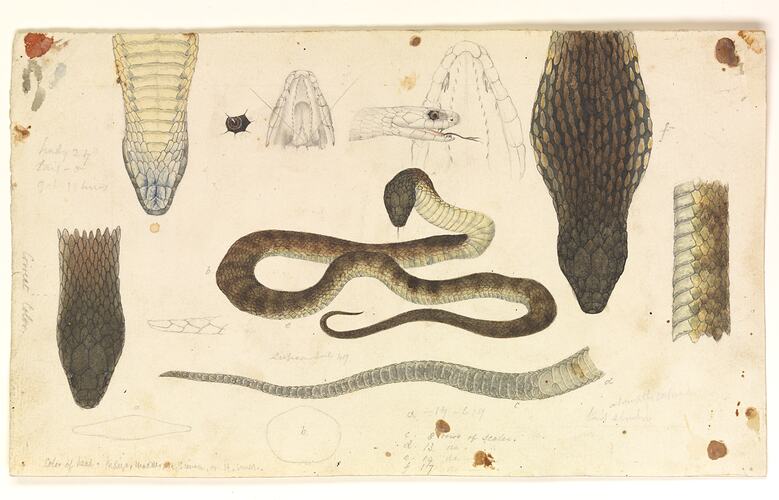Tiger Snake, Notechis scutatus
Plate 3. Tiger Snake, Hoplocephalus curtus (now known as Tiger Snake, Notechis scutatus) caught at the junction of the Murray and the Darling Rivers, Melbourne
This species which goes under the colonial name in Victoria of Tiger Snake from its tawny cross-banded coloring, and ferocity, is well know to frequently inflict bites rapidly fatal to men and dogs, and is extremely ferocious in disposition, reminding us strongly of its near ally, the Cobra di capello of India, like which it flattens and extends the skin of the side of the neck laterally when irritated, to twice its width when quiet; the black stretched skin being then very visible between the separated scales. It is common, especially on marshy places and near river-banks around Melbourne, and in most parts of the colony, as well as extending far beyond it to the warm north, and just as abundantly to the cool south of Tasmania.
The bands vary very much in distinctiveness, and are often very obscure near the head and tail; in some specimens they are rendered very conspicuous by an extension of some of the yellowish color of the belly on to two or three rows of the lateral scales between the ends of the bands. The blue on the chin is rarely seen, and soon disappears in specimens of spirit, exhibiting it when alive. As in all snakes the colors are most vivid just after casting the skin, and are darker and the markings less distinct before it. The fangs are single or double, small, under the junction of the second and third labial plates; one or two (rarely four) smaller teeth under the anterior part of the fourth labial plate. Iris orange; the pupils seem circular, and not vertically elongate, as Schlegal states in his "Essai sur la Physionomie des Serpens."
In Tasmania this is popularly called "Carpet Snake," a name which properly belongs to the harmless snake so called on the mainland. In this case, as with the H. superbus, the Tasmanian experiments on the treatment of bites from this highly poisonous species were unintelligible in Europe from the misuse of the established popular name of a different and innocuous form.
The greater number of fatal cases of snake-bites to men and dogs near Melbourne, and most of the experiments by Professor Halford and others to test the power of the poison, and the efficacy of the injection of ammonia into the blood, and other modes of treatment, refer to this species, which is by far the most abundant of all the dangerous snakes of the colony. In Dr. Halford's experiments at the University of Melbourne, of 31 dogs bitten by active Tiger Snakes, 27 dies and 4 recovered; the deaths occurring, on the average, in 2 hours 2 minutes. Deputy-Inspector-General MacBeth, causing 29 dogs to be bitten by Cobras found they all died, on the average, in 2 hours 42 minutes, showing that, contrary to the expressed opinion of many Indian practitioners, the Australian Tiger Snake is more rapidly fatal than that of the Cobra. Dr. McCrae, the Chief Medical Officer of Victoria, caused 14 dogs to be bitten by this species of snake, and none recovered. No remedies were used in any of these three sets of cases. The number of deaths of human beings in the colony from snake-bite in a year is very small; but some of the cases given in the Australian Medical Journal for March 1875 are interesting from the bites being publicly given in Melbourne, and the precise times noted both of the bite and the death of the man. One, a police magistrate bitten on the arm by a Tiger Snake, died in 24 hours; a man named Underwood, a well known vendor of a supposed antidote, was bitten in public by one of this species and was dead within an hour; another man named Cartwright, exhibiting some of these snakes, was bitten and also died within an hour. Dr. Casey, of Brighton, reported a case in which a man died within a half hour of the bite; and a man named Griffiths, handling some of these snakes as an exhibition at the Port Phillip Club Hotel, was bitten by a Tiger Snake, and died in less than half an hour. The symptoms seem to be much alike in all cases if snake-bite, viz.:-At first faintness and slight convulsions, then sickness of the stomach (probably a reflex action from the brain), with trembling and weakness in the limbs ; the pupils of the eyes dilated, a tendency to sleep, and then total paralysis and coma immediately preceding death.
The young of the Tiger Snake are about thirty in number, like the adult in all respects, and brought forth in January. The general food of the Tiger Snake is composed of frogs, lizards, and mice, &c. On one occasion, however, I put a live mouse into a box in which I had a Tiger Snake, to feed it, and was astonished to find the next morning that the mouse had killed the snake by biting the back of its neck, and had eaten some of its flesh. Keeping some of these snakes together in a box, I frequently noticed then bite each other vigorously when stirred up, without the poison-fangs producing any ill effect.
View plate and full description in the Biodiversity Heritage Library
